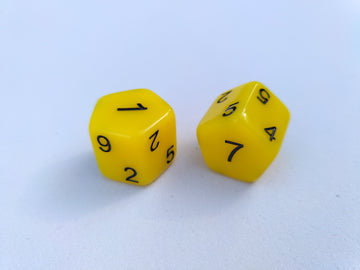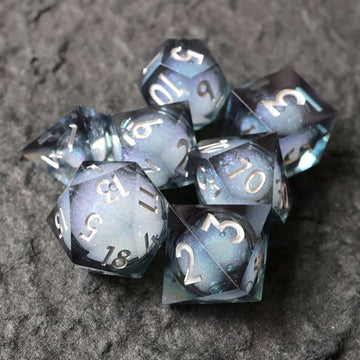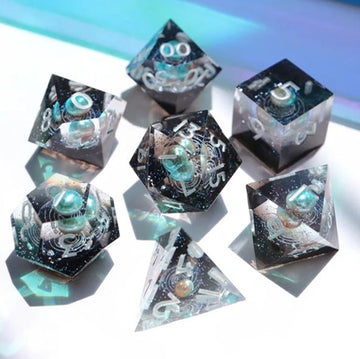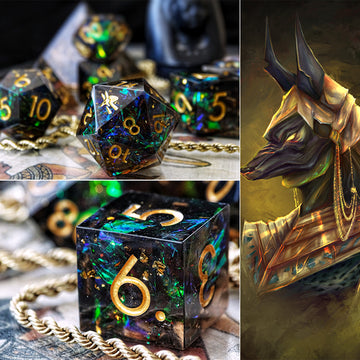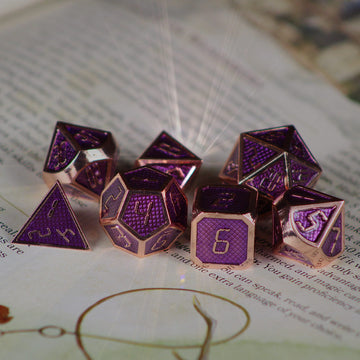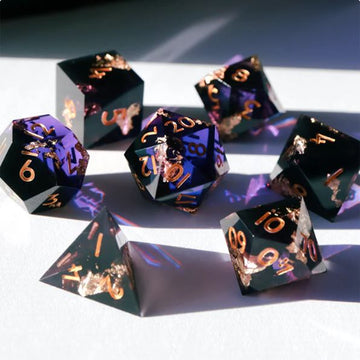by Herman Jacobs
When I saw the black and white d7 from Gamescience for the first time, I was fascinated. Finally, a proper d7. Of course, there were d7 spinners and d7 bar dice, but those weren't the real deal. And neither was the d14 with repeating numbers 1 through 7.

Gamescience d7
Gamescience's d7 was the first asymmetrical die I had come across. I wondered: could this die be fair? Obviously, the answer is that it cannot. One reason for that is, unlike with symmetrical dice, the surface on which an asymmetrical die is rolled has an influence on the outcome.
What I didn't like about the Gamescience die was the mixed use of numbers (for the 6 and 7) and pips (for numbers 1 through 5). It wasn't very consistent and it made it so one couldn't combine this d7 with other dice sets. D&D players love matching dice sets.
The shape of the Gamescience d7 wasn't new. In the middle ages, people were already using the pentagonal prism for a d7. The only difference between these dice and the Gamescience d7 was that medieval dice used pips instead of numbers on the pentagonal sides. The layout, however, was the same.
The pentagonal sides of the d7 have the most space and can therefore harbor the most pips, hence the decision to put pips for 6 and 7 on those sides.
Unfortunately, this makes these old d7s even more unreliable than the new design. The d7 has two types of sides: wider pentagonal sides occupied by the 6 and 7, and smaller rectangular sides occupied by numbers 1 through 5. When the surface the die is rolled on favors only one of these sides, it leads to just high or low rolls.

In my opinion, the Gamescience d7 had two problems: it was not fair and it had an inconsistent representation. How could I solve these issues?
To make symmetrical dice fair, each die has its high values placed opposite to its low. This is why two opposite sides on a d6 always equal 7. Why not use this principle on the d7 as well? Place 1 and 7 on the larger, pentagonal sides and the rest on the smaller, rectangular sides. Now the average of the large sides is (1 + 7) / 2 = 4 and the average of the small sides is (2 + 3 + 4 + 5 + 6) / 5 = 4. In other words, the average will always be 4, no matter the surface.
I used this same reasoning to determine which numbers should be next to each other on each rectangular side. Beside each high number, the lowest number is placed. The starting line was 2 - 6 - 3. Next to the lowest number, the highest remaining number was placed. This resulted in 5 - 2 - 6 - 3. Only the 4 was left, so the end result was 5 - 2 - 6 - 3 - 4.

After layout, representation was considered. The die should have either pips or numbers. Earlier, we encountered the problem with pips (they occupy a lot of space), so numbers it was.
For the rectangular sides, placing numbers on the edges would make the die hard to read. Therefore, I chose to place the numbers on either side of the edge. The same number appears twice, once on either side of the edge.
And so the new standard d7 was born. Because it is asymmetrical, it's still not entirely fair, but it is much more fair than previous designs. Furthermore, it blends in well with a traditional set of D&D dice, which feels comfortable. Because we should leave the inconsistencies with the roleplay and not with the dice.

